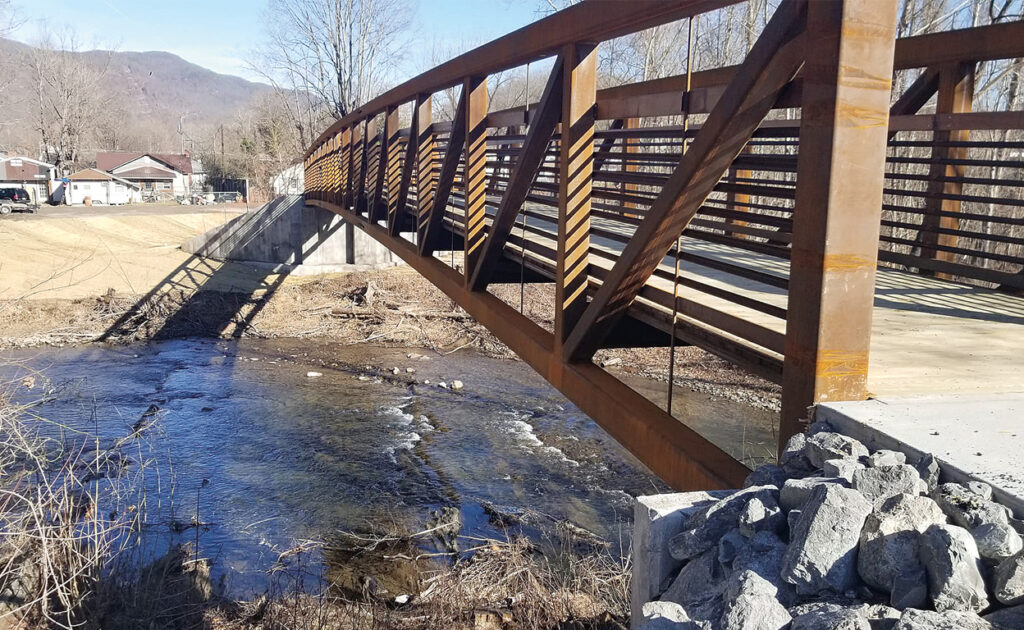
By A.J. Kaufman, Managing Editor
For parts of the Appalachian Highlands to continue an economic rebound, the rehabilitation and enhancement of various locations is a crucial economic development driver.
From embracing tourism to diversifying economies, efforts in multiple downtowns are helping with community development. These can include unique visitor experiences like dining, retail shopping, along with outdoor recreation to boost tourism businesses and connect travelers with natural and cultural assets.
Many places are working hard to do just that. Let’s take a view of the region’s multifaceted economic landscape and assorted entrepreneurial endeavors.
St. Paul conveniently sits about halfway between Abingdon and Wise. Perched along the Clinch River — which is always open for fishing, kayaking and canoeing — the town of 1,000 received a sizable Industrial Revitalization Grant for a tourism asset.
Clinch River State Park, the commonwealth’s newest, has become an outdoor tourism destination. Located just west of town, Spearhead Trails’ Mountain View Trail has access to over 100 miles of trails for ATVs and dirt bikes.
Indoors, the Lyric Theater recently marked one year since its reopening and was a major redevelopment project over a decade. The Western Front Hotel is a boutique venue and another large redevelopment project in St. Paul. There are several new murals in town, one which is featured on the Appalachian Mural Trail.
A project to redevelop the Deen Building, a century-old department store, into a 3,600 square foot distillery and restaurant, also recently began.
UVA-Wise’s Oxbow Center is also located in St. Paul. The Center serves multiple functions, particularly as a working space for companies, facility rentals for community and organizational events, as well as home to the Clinch River Ecological Educational Center. This Center for environmental education programs features an overnight housing complex available to those studying or performing service in the region.
“Revitalization in St. Paul is due to strategic planning, along with private and public investments,” Kathy Stewart, Main Street Manager for St. Paul Tomorrow, Inc., told the Business Journal. “We have made these investments work by focusing on ecological awareness, outdoor recreation, tourism, business development and quality of life. St. Paul became a designated Virginia Main Street community in 2011, which has also helped us develop local and regional partnerships to fulfill our vision of a thriving community.

About 30 miles west through the rolling hills sits Big Stone Gap. The largest town in Wise County at over 5,000 residents, their local economy long centered around the coal industry.
According to Director of Tourism and Economic Development Ked Meade, as coal production decreased, the best option was to change directions and begin a new way of thinking, especially via tourism.
“We had a lot of great things and didn’t tell anyone,” Meade told the Business Journal.
He says the town always had an emphasis on music, the outdoors and its unique heritage; they’ve recently increased their social media presence to promote those stories.
The Big Stone Gap native has lived around the world but eventually came back to Southwest Virginia and assumed his current role in 2021.
“The further I got away, the more I wanted to come home,” Meade claimed, then added, “After COVID, the whole world took a different look at small town USA. They looked for out of the way places like here, so they could be outside. We leveraged partners. We became a destination marketing organization for Wise County. We basically took it upon ourselves to tell the world about our surrounding area and region…In a nutshell, you just gotta find what you truly have in abundance and tell the world about it. Somebody out there will like it.”
Upcoming events in Big Stone Gap include the “Gathering in the Gap” old-time and bluegrass music festival on May 25 and the Mountain Empire Community College Golf Classic May 31 at Lonesome Pine Country Club. A day later Free Ride Day, where the Southwest Regional Recreation Authority offer residents and visitors an opportunity to experience all the regional trails have to offer, free of charge.
In terms of construction, there are planned renovations to the historic bus terminal to allow incubator space for several small businesses or a large venue for one business.
The Greenbelt Trail, which surrounds the town and follows the Powell River — which begins in northern Wise County mountains and empties into the Clinch — can be accessed near Big Stone Gap. The town is also adding bridges to link the walking, biking and nature trail with other trails throughout the county.
Down along the state line, “Believe in Bristol” announced an effort to enhance the look of Historic Downtown Bristol with the 2024 Facade Improvement grant program.
With funding from the Tennessee Main Street Downtown Improvement Grant and the Virginia Department of Housing and Community Development Downtown Investment Grant, a total of 25 properties were selected as April began to receive a combined sum of $172,500 in reimbursement grants to undertake improvement projects on their buildings.
Downtown Bristol also continues their First Friday events. State Street was filled with art lovers and connoisseurs as April began, with several galleries joining together to host an “Art D’Vine” event. The art walk gives patrons after-hours access to merchants, refreshments, and a range of works from regional artists.
Photos courtesy of Ked Meade, Kathy Stewart and the Town of Big Stone Gap.



